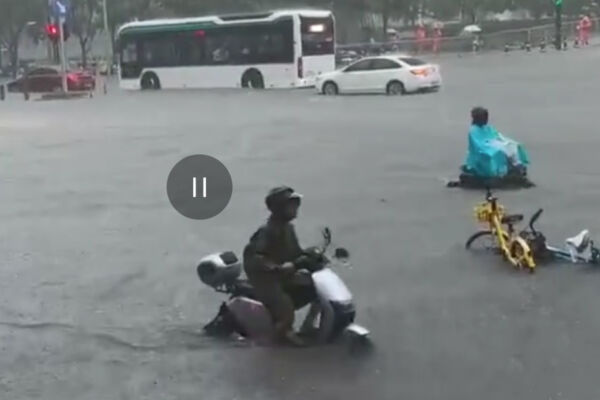Typhoon “Purasang”, the 14th of this year, made its second landfall along the coast of Fengxian District in Shanghai around 9:45 pm on September 19. This led to showers and thunderstorms in multiple areas of Shanghai, with heavy rain in Pudong, Fengxian, Jinshan, Qingpu, and the eastern part of Chongming, causing urban flooding. Some netizens reported waking up to find their homes submerged: “Woke up and everything was flooded.”
According to the Shanghai Flood Control Command, as of 9:00 am on the 20th, the city’s average rainfall reached 73.28 millimeters, mainly concentrated in Fengxian District, Pudong New Area, and Minhang District. The maximum accumulated rainfall was 340.9 millimeters at the Yangjiazhai Meteorological Observatory in Fengxian, while the maximum hourly rainfall was 116 millimeters at the Nicheng Park Meteorological Observatory in Pudong. Both stations accumulated over 300 millimeters of rain in 6 hours, breaking historical records for both Pudong and Fengxian. A total of 22 hydrological stations, including Huangpu Park and Mishidu, exceeded their alert levels.
On the night of the 19th, a netizen from Pudong shared a video saying, “The power pole short-circuited, had to fight against flooding in the middle of the night.” The video showed strong winds and heavy rain from the typhoon hitting the windows, water seeping into the house through the gaps. The uploader hurriedly used towels and clothes to absorb the water, but it kept flowing in.
By the morning of the 20th, many netizens expressed their shock at the flooding: “Woke up and everything was submerged.” “It’s the first time in over a decade in Shanghai to see water levels this high.” “It was pouring rain when I woke up.” “Feels like a waterfall outside.”
Videos shared by netizens showed severe flooding in areas like Lingang New Area and the Huinan Metro Station in Pudong, with water levels reaching knee-high. In addition, parts of Xuhui District also experienced significant flooding.
In the videos, residential areas and streets were inundated, with many vehicles submerged in water, and pedestrians struggling to move through. Some homes were flooded as well.
Mr. Jiang, a resident of Pudong New Area, told The Paper that after listening to the sound of wind and rain all night, the windshield of his car was covered in heavy rain when he left the underground parking lot at 7:30 am. He had to keep the wipers at the fastest speed and drive at around 50 km/h. Driving from the Expo area to Lujiazui, he found that some road sections were already deeply flooded, making it feel like he was driving a boat.
A netizen shared a video saying, “Shanghai has turned into a sea-view mode.” Others expressed, “The southern part of Pudong in Shanghai is overwhelmed. Water cut off, garages flooded, and roads suitable for rowing boats.”
Due to the impact of Typhoon “Purasang”, Fengxian Wujie Town in Shanghai issued a red alert for heavy rain and announced the suspension of six activities at 5:15 am on September 20. One minute later, Pudong in Shanghai also issued a red alert for heavy rain, with 16 towns initiating the suspension of six activities. A total of 334 schools in 21 towns in Pudong, Fengxian, and other districts suspended classes, affecting 280,000 students.
According to meteorological data, since 1949, there have been four typhoons that landed in Shanghai in September. Typhoon “Bebika” on September 16 became the strongest typhoon to land in Shanghai since 1949. “Purasang” followed “Bebika” with another landfall.
The China Meteorological Administration stated that having two autumn typhoons hit consecutively within four days is unprecedented for Shanghai.
In the early morning of the 20th, the center of “Purasang” moved from Shanghai to Kunshan City in Jiangsu Province, entering Jiangyin City in Jiangsu Province at 5:00 am.

